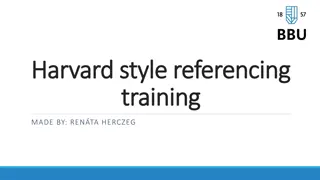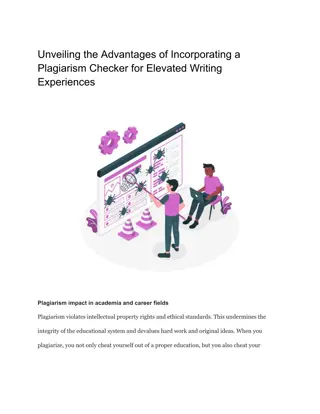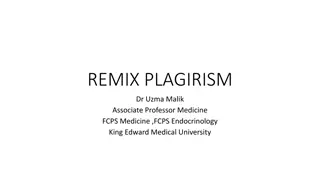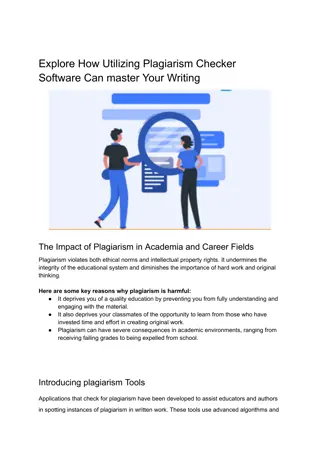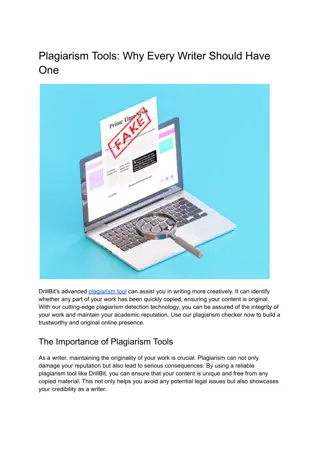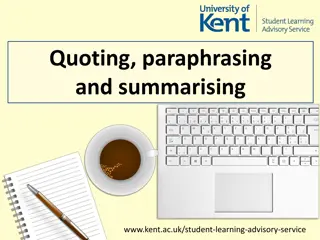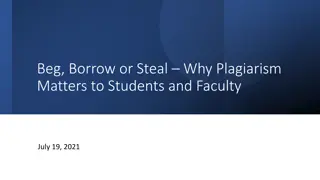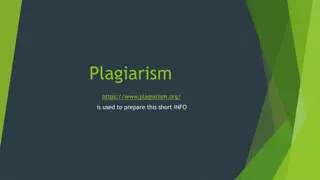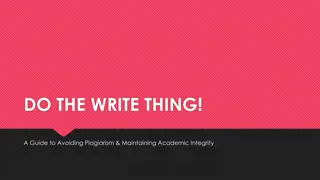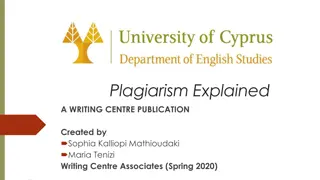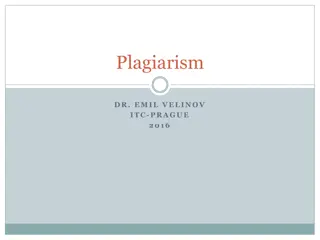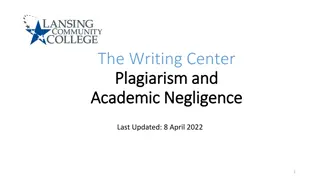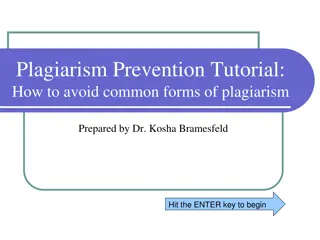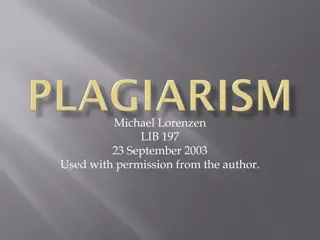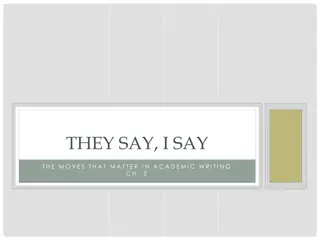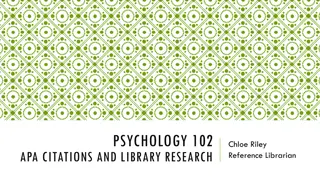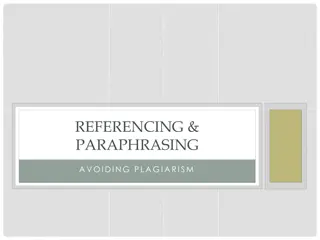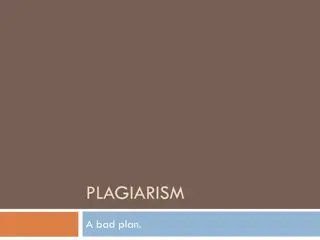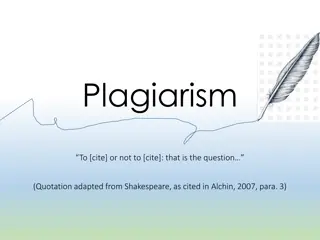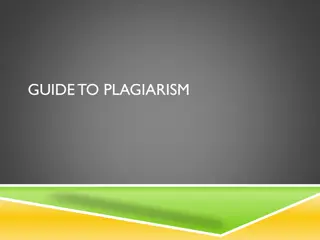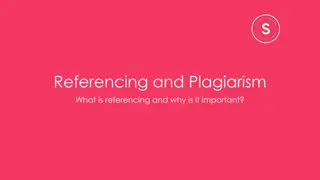Effective Techniques for Summarizing and Avoiding Plagiarism
Effective strategies for summarizing include understanding the text, selecting relevant information, and rewriting main ideas in your own words. To avoid plagiarism, utilize direct quotations with proper citations, practice paraphrasing, and synthesize information from various sources. A good summary should acknowledge the original author, present ideas objectively, and contain only key information in a concise manner.
Download Presentation

Please find below an Image/Link to download the presentation.
The content on the website is provided AS IS for your information and personal use only. It may not be sold, licensed, or shared on other websites without obtaining consent from the author.If you encounter any issues during the download, it is possible that the publisher has removed the file from their server.
You are allowed to download the files provided on this website for personal or commercial use, subject to the condition that they are used lawfully. All files are the property of their respective owners.
The content on the website is provided AS IS for your information and personal use only. It may not be sold, licensed, or shared on other websites without obtaining consent from the author.
E N D
Presentation Transcript
Summarizing and Paraphrasing by Zhuo Li Center for Language Education
Working with others ideas and voices Source: https://www.msn.com/en-ph/entertainment/entertainment-asianbuzz/plagiarism-costs- chinese-film-star-zhai-tianlin-his-phd/ar-BBTTLWD?li=BBr8Mkn
How to avoidplagiarism? Direct quotation(10% of the text allowed) Quotation marks In-text citation: author(s), year of publication, and page number Referencelist Reporting Summarizing (long paragraphs, pages, or chapters) Paraphrasing (alternative to direct quoting) Synthesizing (a combination of several texts made into one)
Summarizing 7 Original: Seawater covers 361 million square kilometers which represents 71% of the surface of the globe. The total volume of water is enormous: 1.37 thousand million cubic kilometers. Most of this water is contained in the three great oceans of the world: the Pacific,Atlantic and Indian Oceans (Holden,2008, p.57). Summary: The surface of the earth comprises 71% seawater, most of which can be found in the India, Pacific and Atlantic Oceans (Holden, 2008). Features you identify Summarizedversion Length oftext Shorter Delete the details
How tosummarize Read and understand the text carefully Think about the purpose of the text Select the relevantinformation Find the main ideas - what isimportant Change the structure of thetext Rewrite the main ideas in completesentences Check yourwork. Source: http://www.uefap.com/writing/writfram.htm
A good summary should Acknowledge the original author Refer to the writer and/or the title of the work in a formal way Present the writer s ideas objectively, without your opinion Contain only the most important information Thetopic Thethesis The key ideas that support or explain thethesis Be much shorter than the original writing Dollahite, N.E. & Haun, J. (2012). Source work: Academic writing for sources. Boston: Heinle/CengageLearning.
P araphrasing Original: The mere physical proximityof one person to another is a potent facilitator of attraction (Martin et al., 2007, p.757).
P araphrasing Original: The mere physical proximity of one person to another is a potent facilitator of attraction (Martin et al., 2007, p.757) Paraphrase: Attraction between two people is greatly influenced by theirphysical closeness (Martin et al.,2007) Original Paraphrase PhysicalProximity Physicalcloseness Of one person toanother Between two people X is a potent facilitator ofY (nominalization) Physical proximity is the subject of the sentence. Y is greatly influenced byX Attraction is the subjectof thesentence.
Acceptable or unacceptable? "The number of children who are adopted each year in Fiji is small relative to the number of children whoneed homes. This is very tragic" (Smith, 1987, p.58). StudentA: The number of children who are adopted each year in Fijiis small relative to the number of children who need homes (Smith,1987). Student B: Tragically many children need to be adopted in Fiji, and not enough are adopted. StudentC: The number of kids who are adopted every year in Fiji is minorrelativeto thenumber of kids who need homes(Smith,1987). This is very sad(Smith,1987). Source: http://www.correspondencestudy.ufl.edu/students/handbook/Plagiarism/PlagiarismQuiz.html
Acceptable or unacceptable?-Contd Original: "The number of children who are adopted each year in Fiji is small relative to the number of children who need homes. This is very tragic" (Smith, 1987, p.58). [26] Paraphrase: According to Smith (1987), it is a sad situation in which less children are actually adopted than those who are in need of adoption in Fiji every year. [28] Original The number of X is small relative toY Paraphrase Less X are thanY Eachyear Everyyear In need of adoption Need homes This is verytragic. It is a sad situation inwhich
How toparaphrase Read and understand the text Make a list of the mainideas Find the importantideas/words/phrases Find alternative words/synonyms for thesewords/phrases Change the structure of thetext Rewrite the main ideas in completesentences Check yourwork Make sure the meaning is the same. Make sure the length is thesame. Make sure the style is yourown. Remember to acknowledge other people's work Source http://www.uefap.com/writing/writfram.htm
A Good paraphrase should Have the same meaning as the original All main ideasincluded No new ideasadded Be different enough from the original to be considered your ownwriting Uses no more than four or five words in a row from the original Change grammar and vocabulary as much aspossible Refer directly to (or cites) the original source Include the name of the author and/or the name of the source Dollahite, N.E. & Haun, J. (2012). Source work: Academic writing for sources. Boston: Heinle/CengageLearning.
R eferences Dollahite, N.E. & Haun, J. (2012). Source work: Academic writing for sources. Boston: Heinle/Cengage Learning. Gillett, A. (2008). Using English for academic purpose: A guide for students in higher education: Academic writing. Retrieve fromhttp://www.uefap.com/writing Gillett, A., Hammond, A., & Martala, M. (2009). Inside track: Successful academicwriting. London:Longman.
References Dollahite, N.E. & Haun, J. (2012). Source work: Academic writing for sources. Boston: Heinle/Cengage Learning. Gillett, A. (2008). Using English for academic purpose: A guide for students in higher education: Academic writing. Retrieve fromhttp://www.uefap.com/writing Gillett, A., Hammond, A., & Martala, M. (2009). Inside track: Successful academicwriting. London:Longman.


